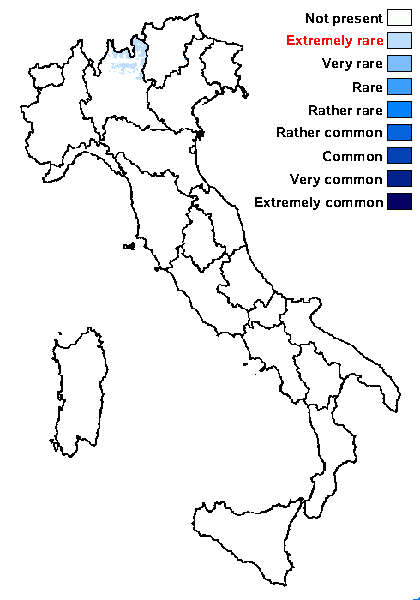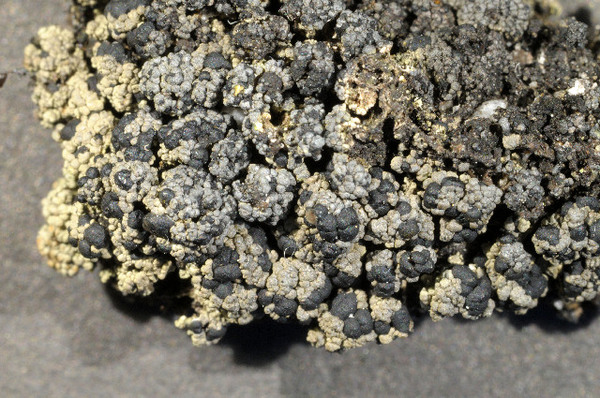Gilbertaria squalescens (Nyl.) M. Svensson & Fryday
Mycological Progress: 16 , 2022. Basionym: Lecidea squalescens Nyl. - Öfvers. K. Svensk. Vetensk.-Akad. Förh., 17: 297, 1860.
Synonyms: Bacidia sphaeralis (Körb.) Erichsen; Biatorina sphaeralis (Körb.) Jatta; Buellia sphaeralis (Körb.) Anzi; Catillaria kivakkensis Vain.; Catillaria sphaeralis Körb.; Lecidea subramosa J. Lowe; Thalloidima rimulosum Th. Fr.; Thalloidima squalescens (Nyl.) Stein in Cohn; Toninia squalescens (Nyl.) Th. Fr.
Distribution: N - Lomb.
Description: Thallus crustose-subsquamulose, olivaceous grey, ash-grey or grey-brown, usually epruinose, consisting of irregular, 0.3-0.5(-0.8) mm wide, convex, bullate to substipitate squamules with entire to crenate margins, coalescing into 1-2(-3) cm wide patches. Upper cortex up to 20 μm thick, lacking crystals; medulla white, sometimes becoming hollow in larger squamules, lacking crystals. Apothecia biatorine, 0.3-0.8(-1.5) mm across, glossy black, sessile and more or less constricted at base, rounded, sometimes confluent, with a strongly convex, epruinose, disc, without an evident proper margin. Proper exciple not apparent; epithecium patchily blue-green, 8-13 μm high, K+ brighter green, N+ magenta; hymenium colourless, but often with pigmented vertical streaks originating from the epithecium, (40-)50-70(-75) μm high, hemiamyloid, I+ blue turning reddish; paraphyses 2-3(-4) μm thick, slightly branched in upper part, strongly coherent, the apical cells not swollen; hypothecium up to 350 μm high, densely opaque, the upper 50-75 μm dilute brown (K–, N+ dilute golden-brown) with darker spots, the lower part more or less colourless, K/I+ blue. Asci 8-spored, cylindrical-clavate, with a K/I+ blue apical dome penetrated by a narrow, K/I- apical cushion surrounded by a narrow, deeply K/I+ blue zone, the wall K/I- but surrounded by an I+ red-brown and K/I+ blue outer layer, the ocular chamber small, Biatora-type. Ascospores (0-)1(-3)-septate, hyaline, ellipsoid-dacryoid with a slightly pointed end, (5-)6-11(-12) x (2.5-)3.5-5(-5) μm. Photobiont chlorococcoid, the cells 6–12 μm wide. Spot tests: thallus K-, C-, KC-, P-, UV- or UV+ faintly grey or white. Chemistry: unknown, perhaps without lichen substances. Note: on silicicolous mosses, mostly on Andreaea near or above treeline. For further details see Svensson & Fryday (2022).
Growth form: Crustose
Substrata: rocks, soil, terricolous mosses, and plant debris
Photobiont: green algae other than Trentepohlia
Reproductive strategy: mainly sexual
Poorly known taxon in need of further study
Commonnes-rarity: (info)
Alpine belt: extremely rare
Subalpine belt: extremely rare
Oromediterranean belt: absent
Montane belt: absent
Submediterranean belt: absent
Padanian area: absent
Humid submediterranean belt: absent
Humid mediterranean belt: absent
Dry mediterranean belt: absent

Predictive model
Growth form: Crustose
Substrata: rocks, soil, terricolous mosses, and plant debris
Photobiont: green algae other than Trentepohlia
Reproductive strategy: mainly sexual
Poorly known taxon in need of further study
Commonnes-rarity: (info)
Alpine belt: extremely rare
Subalpine belt: extremely rare
Oromediterranean belt: absent
Montane belt: absent
Submediterranean belt: absent
Padanian area: absent
Humid submediterranean belt: absent
Humid mediterranean belt: absent
Dry mediterranean belt: absent

Predictive model
 Index Fungorum
Index Fungorum
 GBIF
GBIF



